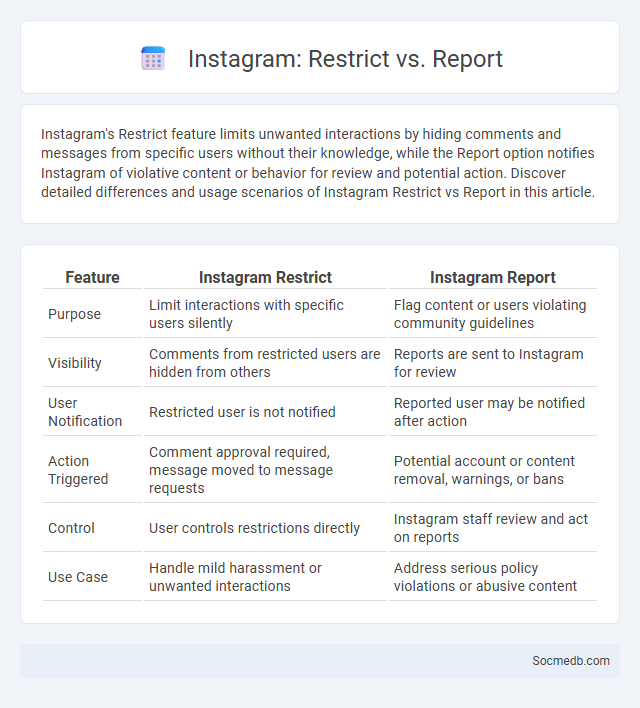
Photo illustration: Instagram Restrict vs Report
Instagram's Restrict feature limits unwanted interactions by hiding comments and messages from specific users without their knowledge, while the Report option notifies Instagram of violative content or behavior for review and potential action. Discover detailed differences and usage scenarios of Instagram Restrict vs Report in this article.
Table of Comparison
| Feature | Instagram Restrict | Instagram Report |
|---|---|---|
| Purpose | Limit interactions with specific users silently | Flag content or users violating community guidelines |
| Visibility | Comments from restricted users are hidden from others | Reports are sent to Instagram for review |
| User Notification | Restricted user is not notified | Reported user may be notified after action |
| Action Triggered | Comment approval required, message moved to message requests | Potential account or content removal, warnings, or bans |
| Control | User controls restrictions directly | Instagram staff review and act on reports |
| Use Case | Handle mild harassment or unwanted interactions | Address serious policy violations or abusive content |
Introduction to Instagram's Safety Tools
Instagram offers a range of safety tools designed to protect users from harassment, bullying, and harmful content, including comment filters, message controls, and reporting features. These tools leverage AI algorithms to detect and hide offensive language automatically, enabling a safer environment for diverse communities. Privacy settings allow users to manage who can interact with their content, ensuring greater control over their social media experience.
What Does “Restrict” Mean on Instagram?
The "Restrict" feature on Instagram allows you to limit interactions without blocking someone completely, preventing them from seeing when you're online or if you've read their messages. When you restrict a user, their comments on your posts are only visible to them unless you approve otherwise, enhancing your control over your social media experience. You can manage these settings privately, ensuring your online space remains safe and comfortable without escalating conflicts.
How Does “Report” Work on Instagram?
When you use the "Report" feature on Instagram, your action flags specific content, such as posts, comments, or profiles, for review by Instagram's moderation team. This report is then evaluated based on Instagram's Community Guidelines, focusing on issues such as spam, harassment, inappropriate content, or copyright violations. You can ensure your report helps maintain a safer Instagram environment by selecting the most accurate reason for the issue you want to address.
Restrict vs. Block: Key Differences
Restrict limits interactions by hiding your comments and stories from a specific user without notifying them, allowing you to control your social media experience discreetly. Block completely cuts off communication and visibility, preventing the user from finding or interacting with your profile entirely. Understanding these differences helps you manage your privacy effectively on platforms like Instagram and Facebook to suit Your comfort level.
Step-by-Step Guide to Restricting an Account
To restrict an account on social media platforms such as Instagram, start by navigating to the user's profile and tapping the menu icon. Select "Restrict" or "Privacy Settings" and confirm your choice to limit the user's interactions, including comments and messages. This feature helps maintain privacy by automatically hiding comments from the restricted account and preventing the user from seeing when you are active or if you have read their messages.
When Should You Report Rather Than Restrict?
You should report content on social media when it violates platform policies or poses a threat to safety, such as hate speech, harassment, or misinformation. Restricting is suitable for less severe issues like unwanted comments or minor disturbances, allowing you to control interactions without escalating. Understanding when to report ensures effective protection of your online environment and community standards.
Privacy Impact: Restrict vs Report on Instagram
Instagram's Privacy Impact features include "Restrict" and "Report," designed to enhance user safety and control over interactions. The "Restrict" option allows users to silently limit interaction by hiding comments and messages from specific accounts without notifying them, reducing potential harassment discreetly. In contrast, the "Report" feature flags harmful content or behavior to Instagram's moderation team for investigation and possible removal, helping uphold community standards and protect users from abuse.
What Happens After You Report Someone?
After you report someone on social media, the platform reviews the content based on its community guidelines and policies, using automated systems and human moderators. Your report triggers an evaluation that may result in content removal, account suspension, or warnings if violations are confirmed. Understanding this process helps you know how social media platforms maintain safe and respectful online environments.
Pros and Cons: Restrict vs Report Features
Social media platforms offer Restrict and Report features to enhance user control and safety; Restrict allows users to limit interactions from specific accounts, reducing unwanted engagement without notifying the offender, while Report empowers users to flag harmful content for platform review and potential removal. Restrict provides a subtle, user-friendly way to manage negativity and protect mental well-being, but may not stop severe abuse or widespread harassment effectively. Report escalates serious violations such as hate speech or cyberbullying to moderators, yet can involve delays in response and sometimes leads to inconsistent enforcement.
Choosing the Right Action for Your Situation
Selecting the appropriate social media action depends on understanding your target audience's preferences and engagement patterns. Tailoring content that resonates with your followers increases visibility and drives meaningful interactions. Analyzing platform-specific trends and leveraging data analytics empowers effective decision-making for optimal social media outcomes.
 socmedb.com
socmedb.com